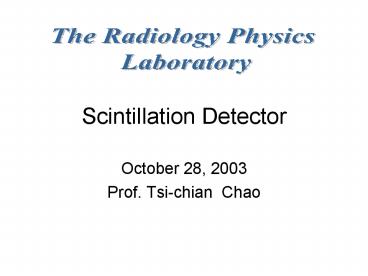Scintillation Detector PowerPoint PPT Presentation
1 / 18
Title: Scintillation Detector
1
Scintillation Detector
The Radiology Physics Laboratory
- October 28, 2003
- Prof. Tsi-chian Chao
2
Scintillation Light
- Fluorescence
- Phosphorescence
- Delayed Fluorescence
3
Types of Detector
- Inorganic material
- Alkali halide crystals (Ex. NaI)
- Best light output linearity
- Slower in response time
- Favor for gamma-ray spectroscopy
- High Z and high density
- Organic-based liquids and plastics
- Generally faster but yield less light
- Preferred for beta spectroscopy fast neutron
detection
4
Ideal Scintillation Material
- High scintillation efficiency
- Linear conversion
- Transparent
- Short decay time
- Good optical quality
- Index of refraction should be near that of glass
5
Organic Scintillators
6
Emission Spectrum
- Self-absorption
- Scintillation efficiency
7
Inorganic Scintillators
The band gap of a typical NaI(Tl) crystal is
about 3eV The scintillation efficient of NaI(Tl)
is about 13
8
Photomultiplier (PM) Tubes
9
Photocathode
- Transfer photons to electrons by the
photoemissive material - Quantum Efficiency (QE)
- Practical photocathodes show maximum quantum
efficiencies of 20-30
10
Dynode
- Convert one electron to many electrons
- Overall multiplication factor
11
Photomultiplier (PM) Tubes
- Some common types of PM tubes
12
Photomultiplier (PM) Tubes
- Some common types of PM tubes-continued
Continuous channel electron multiplier
Microchannel plate electron multiplication
13
Spectroscopy with Scintillators
- Significant Interaction Mechanisms for Gamma-ray
Spectroscopy - Photoelectric absorption
- Predominante for low-energy gamma rays
- Compton scattering
- Most probable process over the range of energies
between two extremes - Pair production
- Predominate for high-energy gamma rays
14
Spectroscopy with Scintillators
- Photoelectric absorption
- Liberation of a photoelectron which carries most
of the gamma-ray energy - Energy gamma-ray energy original binding
energy of the photoelectron - Differential distribution
15
Spectroscopy with Scintillators
- Compton scattering
- Creation of a recoil electron and scattered
gamma-ray photon - Division of energy between the two dependent on
the scattering angle
16
Spectroscopy with Scintillators
- Compton scattering-continued
- A continuum of energies can be transferred to the
electron, ranging from 0 to the maximum (? ?). - As ? ?
- Differential distribution
17
Spectroscopy with Scintillators
- Pair production
- Creation of an electron-positron pair at the
point of complete disappearance of the incident
gamma-ray photon. - Differential distribution
18
Spectroscopy with Scintillators
- Measured pulse height spectrum for 60Co

